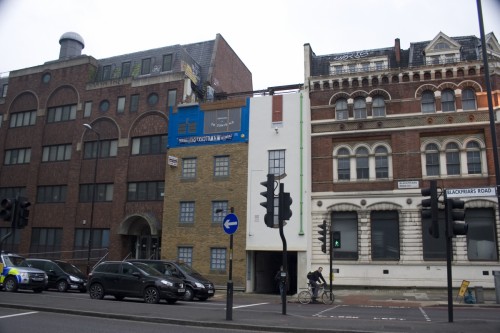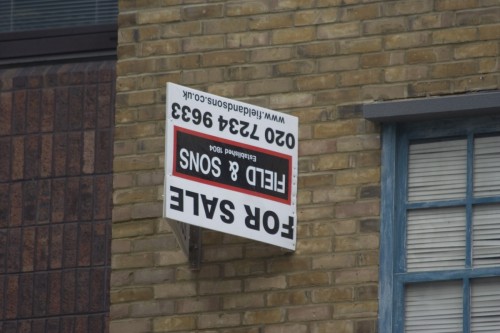A tired old building with a tree growing out of it destined to be torn town and replaced with another anonymous glass and steel tower has — for a while — become a work of art instead.
The building has been turned upside down, in an act that is said in part to mirror how the area is being turned upside down by redevelopments, with old buildings removed and shiny steel replacements arriving.
A lot of that redevelopment is thanks (or blamed) upon the arrival of the Southwark Jubilee Line station, which exists due to political lobbying, and the Palestra building, which is also indirectly there thanks to political actions by a former Mayor of London.
Until recently, a block of buildings, some of which are to vanish, but not the pub, looked a bit like this.
The somewhat shabby front of what was once a photography studio, was today itself the subject of photographers as the final hoardings were removed to reveal the upside down frontage.
You might spy that the new upside down frontage is not an exact replica of what went before, but is a recreation of what might have been there in the past, if not upside down.
The artist, Alex Chinneck describes himself as an architectural artist who likes working with building sized shapes, but also because buildings as art can often blend into their surroundings.
People walking past the upside down house might not even realise it’s upside down, unless they look at it from a distance and start to notice the details.
Then the art stands out as different. He said that public art has a responsibility not to be so noticeable to those who might not like it, but still pleasing to those who know it’s there.
He also quite likes the temporary nature of his work — this piece will be around for a year, or three, but will eventually be torn down and replaced by more skyscrapers.
I quite like art to be temporary, as sometimes there can be a bit of a tendency to treat permanent outdoor art as some sort of holy relic that can never be thrown away, and acts as a barrier to changes in an area later on, or spurs campaign groups to preserve what few had ever noticed before.
In this case, the art is mounted in front of the existing building on a scaffolding structure, which was then coved in a wooden frame and mounted board. The brickwork are thin tiles, and much of the stonework detailing are plaster or foam cutouts designed to be waterproof. Making the whole thing waterproof was quite important, as brick absorbs a lot of water, and weighs a lot when wet — not ideal.
In fact, the engineering needed to build a thin facade on a building has been impressive, and hidden.
The building is itself on occasions hidden, as the best place to see it is on the other side of a main road, with a lot of double-decked buses driving past.
You have a year or so to get to see it though [map link].
If you notice the estate agent sign that hangs upside down on the building. It’s a real estate agent.
And finally, on my way to see the upside down building, I saw an upside down car. That wasn’t art though.















That the car is upside down is more impressive. How do you have an accident that rolls a car over in those narrow streets?
Judging by how often I read in local newspapers about upside down cars, I suspect it’s quite an easy thing to do.
Tsk. You’ve told us where it is! Someone might steel it now! 😉
What about putting a new upside down building in its place
Conveniently close to the Rose & Crown!
[ Upside-down car – easy if you are stupid &/or trying to escape the police … just turn your steering too far, whilst already turning a tight corner, then ‘wing’ a piece of street-furniture – such as the bent traffic-light pole in the picture. Over you go! And, youre a prat, hopefully an arrested prat. ]
Did the car roll over because the driver was doing a double take looking at the upside down house? Thanks for sharing the full story, I cycled past this today and found your article when I searched for details online. It’s a great creation.